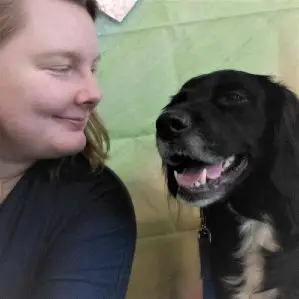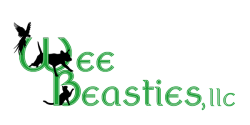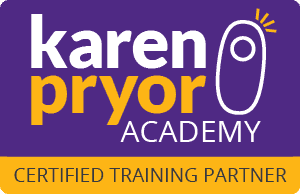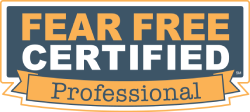About
Experience
I have nearly ten years of experience teaching humans both simple and complex tasks ranging from setting up an email account to speaking foreign languages. This experience helps me tailor our training relationship perfectly for you, no matter what your learning style or current level of understanding. I know how to create a fun and easy-to-understand experience for you and your pet!
In addition to my teaching experience, I have more than five years of handling experience with a variety of companion animals, so I can work with you and your pet in a way that suits you both.
And Education
Education is vital to growth! I have completed a number of educational opportunities, which you can learn more about belolw. Each of these programs has helped me develop knowledge and skills to help you.
I also continually seek out new educational experiences in animal training and behavior so I can share the most effective, science-backed techniques with you—which means a richer training experience for you and your pet alike.

Philosophy & Methods
I am a positive reinforcement trainer. Positive reinforcement is a highly effective and humane training method.
My motto is, if there’s a kind way to do it, then embrace it, and I am morally and ethically opposed to methods that use pain, force, and/or fear to get results.
I use the following methods, which promote confidence, learning, and bonding with your pet:
- Shaping
- Capturing
- Targeting
- Luring
- Classical Conditioning
- Counterconditioning & Desensitization
None of these will ever cause your pet physical injury or psychological harm.

What is Positive Reinforcement?
Positive reinforcement is a style of training that relies on rewarding goal behaviors and managing unwanted behaviors until more acceptable options are trained. It is also commonly referred to as “clicker training,” “marker training,” and “reward-based training.”
Research has shown that punishing unwanted behaviors is unneccesary and often damaging to our pets. It has also shown that mixing reward and punishment training slows learning. Positive reinforcement is easy and fun, and it has a lot of benefits for both owners and pets without any unpleasant side-effects.
My Credentials
I am dedicated to continuing education to improve my services for all of my clients.
KPA-CTP
I’m very proud to have completed the rigorous Karen Pryor Academy Dog Trainer Professional Program with my partner Izzy.
The training program is six months of hands on training and book work, and includes regular testing and demonstration of skill throughout. On completion, students earn the KPA-CTP designation and commit to uphold KPA’s dedication to positive reinforcement, and to continue one’s education throughout the year, even after certification is complete.
UW-AAB
I completed the university level certificate program in Applied Animal Behavior from The University of Washington.
The program develops its students’ understanding of animal behavior and teaches modern, humane techniques for applying the science to our animal companions.
Learn more here.

CTDI
I am a Certified Trick Dog Instructor through Do More with Your Dog. This program requires instructors bring their own dogs to the Intermediate level or higher, and tests their knowledge of training tricks with positive methods.
Trick training is a wonderful bonding experience for both of you.
Fear Free Certified
Fear Free Certified Professionals are committed to making veterinary procedures and grooming more comfortable for your pet by helping them overcome their fears with training. This certification includes a course and tests, as well as a continuing education committment.
My own pets have struggled at the vet, groomer, and even with simple grooming at home, so being a Fear Free Certified Trainer is very dear to me. I understand exactly how simultaneously frustrating and heartbreaking these fears can be for you and your pet!
AKC Canine Good Citizen Evaluator
I’m very pleased to also be certified as an American Kennel Club Canine Good Citizen Evaluator. Working toward and passing the CGC test is a good way for dog owners to help their dogs navigate the world alongside their humans. This test is also a good base for working toward being a therapy and/or service dog.
Choosing a Trainer
It may seem difficult to find a trainer to work with these days, but it doesn’t have to be.
For the best experience, keep the below points in mind.
Communicative
Lots of trainers aren’t people-people! They prefer to work with just animals. However, in this partnership, you are the individual who will need to understand what’s going on at the end of the day. Find someone who is good at helping you understand, changing their pace to fit your needs, and willing to adjust as necessary to help you learn.
Inclusive
The best trainers will include you and your entire family in the training process because that produces the best results. Most pet animals are bad at understanding that doing a “sit” for you is the same as doing it for your five year old. A good trainer will include your family members in the training by at least giving you ways for everyone to practice at home.
Humane
Recent research suggests that dogs may have at least the intelligence of a four year old child. Would you use the methods of your potential trainer to teach a child? If not, consider looking elsewhere. The most effective and humane form of training to date is called “Positive Reinforcement” or reward-based training. A good trainer will use positive reinforcement to teach your pet good behaviors and to solve behavior problems like jumping, barking, and even aggression.
Up-To-Date
Look for someone who participates in continuing education opportunities. You want the most up-to-date methods for solving your problems because they’ll typically save you time and money.
Insured
This protects you, your dog, the trainer, and the space in the case of group classes should something go wrong. Having insurance suggests a higher level of professionalism.
Kind
Find someone who is kind to both your dog and you. Pay attention to how the trainer treats everyone in your classes, including the person that drives you crazy!
Credentialed
Know that presently, anyone can call themselves a trainer. The field requires no training or prior knowledge or practice at all (though that’s starting to change!). You might get someone “who grew up with dogs/cats/etc” or you might find someone who has made studying and working with those animals a career and invested time and money in developing and showing their expertise through education and hands-on experience. Decide which you’d prefer to work with.




